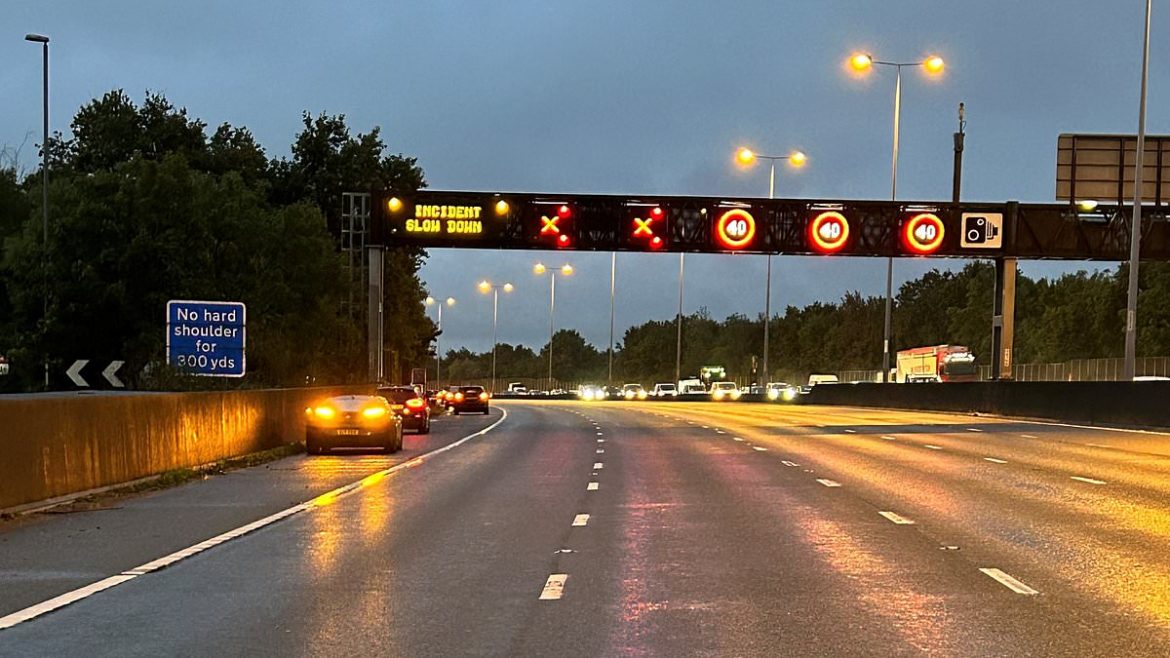The M25, often dubbed the busiest motorway in Britain, was thrown into disarray yesterday when a massive pothole wreaked havoc on unsuspecting motorists.
Many drivers expressed their frustrations, claiming that National Highways failed to provide timely warnings about the perilous hole.
They pointed out that the warning signs only lit up after numerous vehicles had already been affected, leaving many stranded.
Wrecked Vehicles and Lost Flights
Reports from a local tyre company indicate that a staggering 58 vehicles were damaged as drivers found themselves helplessly lined up on the hard shoulder in Surrey.
With cars crippled by the pothole, it wasn’t long before tales of cracked alloy wheels and punctured tyres emerged.
Many drivers recounted spending upwards of £700 to fix their vehicles.
Adding to the chaos, one elderly couple found themselves missing their flight from Gatwick to Cyprus after being stuck behind a crash barrier for over six hours.
Martin Sisley, one of the unfortunate drivers, recounted his terrifying experience.
He was the third driver to hit the pothole and watched in disbelief as more vehicles fell victim.
“It was genuinely frightening,” he shared. “We just stood there, hoping no one would lose control and crash into us.”
According to Mr. Sisley, the matrix signs meant to alert drivers were activated too late, and with only one lane initially closed, it pushed other vehicles directly into danger.
“We were left standing there for about twenty minutes, watching as cars sped past and ended up on the hard shoulder.”
A Slow Response from National Highways
National Highways claimed they were alerted to the pothole around 6 a.m. and dispatched contractors within the hour.
However, the timeline is in question, as one driver reported hitting the hole as early as 3:45 a.m.
Tessa Pearson, 69, was en route to Gatwick with her partner when they encountered the pothole.
After a loud bang, they pulled over only to discover they had damaged their tyres.
“I used my car’s dashboard to call BMW recovery but got cut off twice,” Tessa explained.
In a panic, she pressed the SOS button for police assistance.
After three hours of waiting with no recovery vehicle in sight, she dialed emergency services again, concerned about the increasing traffic.
Finally, after nearly seven hours of waiting in the rain, a recovery van arrived, leaving the couple frustrated and out of pocket by £525 for two new tyres and wheel realignment.
“We missed our holiday and spent hours soaked from the rain,” Tessa lamented.
A Growing Concern for Road Safety
Stephanie Vincent also shared her husband’s ordeal, whose BMW suffered extensive tyre damage due to the pothole.
“It burst both our right-hand tyres,” she said.
“The replacement cost will be over £700, and we expect National Highways to take responsibility.”
Motorists across social media echoed similar sentiments, with one user noting the pothole caused damage to over 20 cars in just a few hours.
In response to the situation, Shepperton Tyres reported receiving an overwhelming number of calls for assistance, with many drivers expressing their dissatisfaction with mobile tyre fitting companies that lacked the necessary stock.
“We were lucky to be prepared, carrying a variety of tyre sizes,” they stated.
The Bigger Picture: Potholes on the Rise
The alarming incident highlights a growing issue on Britain’s roads.
Data from the mobile app Stan the App revealed there were 95 defects along that section of the M25 from January to April alone.
Mike Mockford, the app’s product owner, warned that these problems could lead to more frequent accidents if left unaddressed.
“It’s only a matter of time before someone’s tyre is severely damaged,” he cautioned, noting that authorities seem uninterested in fixing these defects.
While National Highways has not yet confirmed whether they will compensate affected drivers, they do have a process for making claims if damage occurs on their roads.
However, they also warn that there is no guarantee of compensation.
The agency attributed the rise of potholes to “prolonged rainfall” and assured the public that they prioritize safety by repairing defects within 24 hours.
In the wake of this chaos, many are left wondering: what steps will be taken to prevent such incidents in the future?
